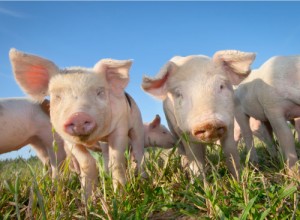Study on activities of pigs
An important application area of Mangold Labs is the research of animal husbandry and animal welfare. Many worldwide universities and research institutes use Mangold Lab Systems for their studies.
A recent study of Julia Brendle and Steffen Hoy of the Department of Animal Breeding and Genetics at the University of Gießen, Germany, examined the locomotion activity by growing pigs in the fattening period by using the software Mangold VideoMotionTracker.

The investigation was carried out with altogether 220 pigs kept in groups of 6 or 12. Every pen was equipped with perforated floor. Water and the in-house compound feed with different elements depending on the fattening period were available ad libitum during the whole fattening period.
At the beginning of each fattening period all pigs were weighed and the individual rank place was calculated based on 72 h continuous infrared video-recordings.
At the beginning, in the middle and at the end of the fattening period the distances covered by focus animals during 24 h were measured using the VideoMotionTracker (VMT) software tool (Mangold).
The VideoMotionTracker is a software solution to allow tracking animals on a video recording using the PC mouse or a touch-screen terminal to measure distances that were covered. This measurements on pigs resulted in highly significant differences between the covered distances at the different fattening stages (at the beginning: 582 m; in the middle: 391 m; at the end: 261 m on average). Fattening pigs kept in groups of 12 each covered longer distances during the fattening period compared with pigs kept in groups of 6 (459 m versus 333 m). The differences between the means were highly significant (p < 0.001). On average female pigs covered a longer distance than castrated male pigs (443 m versus 349 m).
The factor rank position did not show any significant influence on the covered distance of each focus animal. Pigs with high rank positions on average covered 399 m whereas pigs with low rank positions covered with 393 m a marginally shorter distance.
Furthermore the interaction between fattening period and rank position was examined but did not show any significance either. The influence of the factor pen within group size was highly significant (p < 0.001) and the parameters live weight and covered distances were negatively correlated.
Download of the study (pdf) >>>
